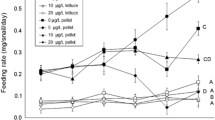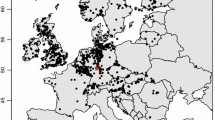Abstract
When spiked in sediments, copper is known to reduce growth of Chironomus riparius larvae and the production of eggs by adult females. The aim of this work was to better understand the origin of these phenomena by studying the effects of copper using developmental and energetic biomarkers, such as changes in larval weight and age and changes in the levels of sugars and lipids. Four-day-old C. riparius larvae were exposed to nominal concentrations of copper of 0, 6.5, 12.5, 25 and 50 mg/kg of dry sediment (silica) in 0.6 l beakers. They were fed ad libitum and exposures were stopped at 7 and 9 days after the beginning of the tests. The larvae were weighed, sexed and aged. For each sex, the larvae belonging to the phases the most frequently found in the beakers were selected for dissection and measurement of energy reserves. The increase in the concentration of copper resulted in an increasing delay in larval growth in both sexes. Desynchronized development was observed, as shown by the increase in the number of individuals that remained in the third instar or early phases of the fourth instar, as well as by a reduction in age of males. Concerning energy reserves, the levels of sugars (glycogen, trehalose and glucose) in the dissected larvae remained almost constant among levels of exposure. In contrast, at the highest copper concentration (50 mg/kg), triglyceride levels suffered a slight reduction whereas the level of free glycerol significantly increased. It is concluded that selection of C. riparius larvae for both sex and age improves the relevance of some energy-yielding substrates as indicators of adverse physiological effects of copper.





Similar content being viewed by others
References
Ali A., Al-Ogaily S.M., Al-Asgah N.A., Gropp J.. (2003). Effect of sublethal concentrations of copper on the growth performance of Oreochromis niloticusJ. Appl. Ichthyol. 19:183–8
Armitage P.D. (1995). Behaviour and ecology of adults In: Armitage P.D., Cranston P.S., Pinder L.C.V (eds) The Chironomidae: Biology and Ecology of Non-Biting Midges. Chapman & Hall, London, UK, pp. 194–224
Belanger S.E., Farris J.L., Cherry D.S., Cairns Jr. J.. (1990). Validation of Corbicula fluminea growth reductions induced by copper in artificial streams and river systemsCan. J. Fish. Aquat. Sci. 47:904–14
Besser J.M., Kubitz J.A., Ingersoll C.G., Braselton W.E., Giesy J.P.. (1995). Influences on copper bioaccumulation, growth, and survival of the midge, Chironomus tentans, in metal-contaminated sedimentsJ. Aquat. Ecosyst. Health 4:157–68
Bischof C., (1995). Effects of heavy metal stress on carbohydrate and lipid concentrations in the haemolymph and total body tissue of parasitized Lymantria dispar L. larvae (Lepidoptera)Comp. Biochem. Physiol.112C:87–92
Calow P., (1991). Physiological costs of combating chemical toxicants: ecological implicationsComp. Biochem. Physiol. 100C:3–6
Campbell H.A., Handy R.D., Sims D.W.. (2002). Increased metabolic cost of swimming and consequent alterations to circadian activity in rainbow trout (Oncorhynchus mykiss) exposed to dietary copperCan. J. Fish. Aquat. Sci. 59:768–77
Carattino M.D., Peralta S., Perez-Coll C., Naab F., Burlon A., Kreiner A.J., Preller A.F., de Schroeder T.M.. (2004). Effects of long-term exposure to Cu2+ and Cd2+ on the pentose phosphate pathway dehydrogenase activities in the ovary of adult Bufo arenarum: possible role as biomarker for Cu2+ toxicityEcotoxicol. Environ. Saf. 57:311–8
Cheung S.G., Wong L.S.. (1998). Physiological responses of the subtidal prosobranch, Babylonia lutosa (Gastropoda: Buccinidae), to copperSci. Total Environ. 214:185–91
Choi J., Roche H., Caquet T.. (2001). Hypoxia, hyperoxia and exposure to potassium dichromate or fenitrothion alter the energy metabolism in Chironomus riparius Mg. (Diptera: Chironomidae) larvaeComp. Biochem. Physiol.130C:11–7
Crawley M.S. (1993). GLIM for Ecologists. Blackwell Science, Oxford, 379 pp
DeBoeck G., Borger R., Van der Linden A., Blust R.. (1997a). Effects of sublethal copper exposure on muscle energy metabolism of common carp, measured by 31P-NMRSEnviron. Toxicol. Chem. 16:676–84
DeBoeck G., Vlaeminck A., Blust R.. (1997b). Effects of sublethal copper exposure on copper accumulation, food consumption, growth, energy stores, and nucleic acid content in common carpArch. Environ. Toxicol. Chem. 33:415–22
De Coen W.M., Janssen C.R.. (2003a). The missing biomarker link: relationships between effects on the cellular energy allocation biomarker of toxicant-stressed Daphnia magna and corresponding population characteristicsEnviron. Toxicol. Chem. 22:1632–41
De Coen W.M., Janssen C.R.. (2003b). A multiple biomarker-based model predicting population-level responses of Daphnia magnaEnviron. Toxicol. Chem. 22:2195–201
De Haas E.M., Paumen M.L., Koelmans A.A., Kraak M.H.S.. (2004). Combined effects of copper and food on the midge Chironomus riparius in whole-sediment bioassaysEnviron. Pollut. 127:99–107
Ducrot V., Péry A.R.R., Mons R., Garric J.. (2004). Energy-based modelling as a basis for the analysis of reproductive data with the midge (Chironomus riparius)Environ. Toxicol. Chem. 23:225–31
Elfwing T., Tedengren M.. (2002). Effects of copper on the metabolism of three species of tropical oysters, Saccostrea cucullata, Crassostrea lugubris and C. belcheriAquaculture 204:157–66
Fischer J., Rosin S.. (1969). Das larvale Wachstum von Chironomus nuditarsis StrRevue Suisse de Zoologie 76:727–34
Forbes V.E., Forbes T.L. (1994). Ecotoxicology in Theory and Practice Chapman & Hall, London, UK, Ecotoxicology Series 2
Gillis P.L., Diener L.C., Reynoldson T.B., Dixon D.G.. (2002). Cadmium-induced production of a metallothioneinlike protein in Tubifex tubifex (Oligochaeta) and Chironomus riparius (Diptera): correlation with reproduction and growthEnviron. Toxicol. Chem. 21:1836–44
Goto M., Sekine Y., Outa H., Hujikura M., Suzuki K. (2001). Relationships between cold hardiness and diapause, and between glycerol and free amino acid contents in overwintering larvae of the oriental corn borer, Ostrinia furnacalis. J. Insect. Physiol. 47:157–65
Hahn T., Schulz R.. (2002). Ecdysteroid synthesis and imaginal disc development in the midge Chironomus riparius as biomarkers for endocrine effects of tributyltinEnviron. Toxicol. Chem. 21:1052–7
Hamburger K., Lindegaard C., Dall P.C.. (1996). The role of glycogen during the ontogenesis of Chironomus anthracinus (Diptera: Chironomidae)Hydrobiologia 318:51–9
Handy R.D., Sims D.W., Giles A., Campbell H.A., Musonda M.M.. (1999). Metabolic trade-off between locomotion and detoxification for maintenance of blood chemistry and growth parameters by rainbow trout (Oncorhynchus mykiss) during chronic dietary exposure to copperAquat. Toxicol. 47:23–41
Ineichen H., Meyer B. and Lezzi M. (1983). Determination of the developmental stage of living fourth instar larvae of Chironomus tentans. Dev. Biol. 98:278–86
Janssens de Bisthoven, L., Timmermans, K.R. and Ollevier, F. (1992). The concentration of cadmium, lead, copper and zinc in Chironomus gr. thummi larvae (Diptera, Chironomidae) with deformed versus normal menta. Hydrobiologia 239, 141–9
Janssens de Bisthoven, L., Vermeulen, A. and Ollevier, F. (1998). Experimental induction of morphological deformities in Chironomus riparius larvae by chronic exposure to copper and lead. Arch. Environ. Contam. Toxicol. 35, 249–56
Karouna-Reinier, N.K. and Zehr, J.P. (2003). Short-term exposures to chronically toxic copper concentrations induce HSP70 proteins in midge larvae (Chironomus tentans). Sci. Total Environ. 312, 267–72
Khangarot B.S., Rathore R.S.. (2003). Effects of copper on respiration, reproduction, and some biochemical parameters of water flea Daphnia magna Straus Bull. Environ. Contam. Toxicol. 70:112–7
Kosalwat P., Knight A.W.. (1987). Chronic toxicity of copper to a partial life cycle of the midge Chironomus decorusArch. Environ. Contam. Toxicol. 16:283–90
Lapointe S.L., Weathersbee III A.A., Doostdar H., Mayer R.T.. (2004). Effect of dietary copper on larval development of Diaprepes abbreviatus (Coleoptera: Curculionidae)Florida Entomol. 87:25–9
Martinez E.A., Moore B.C., Schaumloffel J., Dasgupta N.. (2003). Morphological abnormalities in Chironomus tentans exposed to cadmium- and copper-spiked sedimentsEcotoxicol. Environ. Saf. 55:204–12
Masumura M., Satake S., Saegusa H., Mizoguchi A.. (2000). Glucose stimulates the release of bombyxin, an insulin-related peptide of the silkworm Bombyx moriGen. Comp. Endocrinol. 118:393–9
Michaud J.P., Grant A.K.. (2003). Sub-lethal effects of a copper sulfate fungicide on development and reproduction in three coccinellid speciesJ. Insect Sci. 16:1–6
Mounaji K., Vlassi M., Erraiss N.E., Wegnez M., Serrano A., Soukri A.. (2003). In vitro effect of metal ions on the activity of two amphibian glyceraldehyde-3-phosphate dehydrogenases: potential metal binding sitesComp. Biochem. Physiol. 135B:241–54
Nebeker A.V., Cairns M.A., Wise C.M.. (1984). Relative sensitivity of Chironomus tentans life stages to copperEnviron. Toxicol. Chem. 3:151–8
Nursita A.I., Singh B., Lees E.. (2005). The effects of cadmium, copper, lead, and zinc on the growth and reproduction of Proisotoma minuta Tullberg (Collembola)Ecotoxicol. Environ. Saf. 60:306–14
Ortel J., (1996). Metal-supplemented diets alter carbohydrate levels in tissue and hemolymph of gypsy moth larvae (Lymantria dispar, Lymantriidae, Lepidoptera)Environ. Toxicol. Chem. 15:1171–6
Péry A.R.R., Mons R., Flammarion P., Lagadic L., Garric J.. (2002). A modelling approach to link food availability, growth, emergence and reproduction for the midge Chironomus ripariusEnviron. Toxicol. Chem. 21:2507–13
Péry A.R.R., Ducrot V., Mons R., Miège C., Gahou J., Gorini D., Garric J.. (2003a). Survival tests with Chironomus riparius exposed to spiked sediments can profit from DEBtox modelWater Res. 37:2691–9
Péry A.R.R., Ducrot V., Mons R., Garric J.. (2003b). Modelling toxicity and mode of action of chemicals to analyse growth and emergence tests with the midge Chironomus ripariusAquat. Toxicol. 65:281–92
Redick M.S., La Point T.W.. (2004). Effects of sub-lethal copper exposure on behavior and growth of Rana pipiens tadpolesBull. Environ. Contam. Toxicol. 72:706–10
Ristola T., Pellinen J., Ruokolainen M., Kostamo A., Kukkonen J.V.K.. (1999). Effect of sediment type, feeding level, and larval density on growth and development of a midge (Chironomus riparius)Environ. Toxicol. Chem. 18:756–64
Sarkar S., Duttagupta A.K., Mal T.K.. (2004). Effects of heavy metals on population growth and metallothionein gene expression in the mosquito Culex quinquefasciatus, from Calcutta, IndiaEnviron. Pollut. 127:183–93
Smith R.W., Blaney S.C., Dowling K., Sturm A., Jönsson M., Houlihan D.F.. (2001). Protein synthesis costs could account for the tissue-specific effects of sub-lethal copper on protein synthesis in rainbow trout (Oncorhynchus mykiss)Aquat. Toxicol.53:265–77
Spiegel M.R. (1975). Theory and Problems of Probability and Statistics McGraw-Hill Inc., New York
Stark J.D., Banks J.E.. (2003). Population-level effects of pesticides and other toxicants on arthropodsAnn. Rev. Entomol. 48:505–19
Storey K.B.. (1997). Organic solutes in freezing toleranceComp. Biochem. Physiol. 117A:319–26
Timmermans K.R., Peeters W., Tonkes M.. (1992). Cadmium, zinc, lead and copper in Chironomus riparius (Meigen) larvae (Diptera, Chironomidae): uptake and effectsHydrobiologia 241:119–34
U.S. EPA (2003). 2003 Draft Update of Ambient Water Quality Criteria for Copper. Office of Water, Office of Science and Technology, Washington, DC EPA 822-R-03-026, 71 p
Van der Horst D.J., Vroemen S.F., Van Marrewijk W.J.A.. (1997). Metabolism of stored reserves in insect fat body: hormonal signal transduction implicated in glycogen mobilization and biosynthesis of the lipophorin systemComp. Biochem. Physiol. 117B:463–74
Van Handel E., (1965). Estimation of glycogen in small amounts of tissueAnal. Biochem. 11:256–65
Watts M.M., Pascoe D.. (1996). Use of the freshwater macroinvertebrate Chironomus riparius (Diptera: Chironomidae) in the assessment of sediment toxicityWater Sci. Technol. 34:101–7
Weber L.P., Higgins P.S., Carlson R.I., Janz D.M.. (2003). Development and validation of methods for measuring multiple biochemical indices of condition in juvenile fishesJ. Fish Biol. 63:637–58
Widdows J., Johnson D.. (1988). Physiological energetics of Mytilus edulis: scope for growthMar. Ecol. Prog. Ser. 46:113–21
Wong C.K.. (1993). Effects of chromium, copper, nickel, and zinc on longevity and reproduction of the cladoceran Moina macrocopaBull. Environ. Contam. Toxicol. 50:633–9
Wülker W., Götz P. (1968). Die Verwendung der Imaginalscheiben zur Bestimmung des Entwicklungszustandes vor Chironomus-Larven (Dipt.). Z. Morphol. Tiere 62:363–88
Acknowledgments
This research was supported by the French Ministry of Ecology and Sustainable Development (MEDD), through the “National Programme of Ecotoxicology” (PNETOX). M.J. Servia was granted by a MEDD–INRA–CEMAGREF post-doctoral joint fellowship. The authors thank the technical staffs of the Experimental Unit of Aquatic Ecology and Ecotoxicology (INRA, Rennes, France) and of the Laboratory of Ecotoxicology (CEMAGREF, Lyon, France) for technical support. They also thank Wako Chemicals GmbH (Neuss, Germany) for their generous gift of the glucose reagent kit. They are grateful to Th. Caquet for computing data statistical analysis and for valuable and stimulating discussions.
Author information
Authors and Affiliations
Corresponding author
Rights and permissions
About this article
Cite this article
Servia, M.J., Péry, A.R., Heydorff, M. et al. Effects of copper on energy metabolism and larval development in the midge Chironomus riparius . Ecotoxicology 15, 229–240 (2006). https://doi.org/10.1007/s10646-005-0054-0
Received:
Accepted:
Published:
Issue Date:
DOI: https://doi.org/10.1007/s10646-005-0054-0




